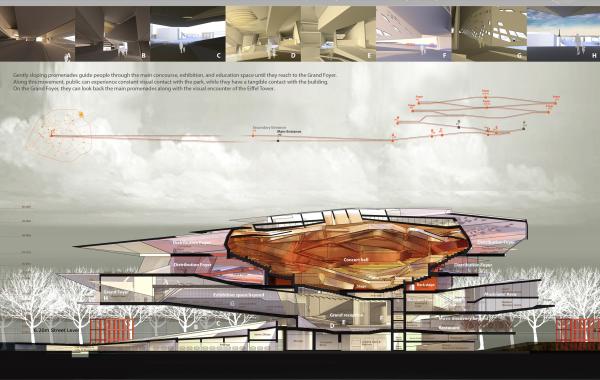Commissioned by the Philharmonie de Paris, this WA Community Awards 6th Cycle winner balances the strict needs of a world class concert hall, with the intricacies of the surrounding neighborhood and the grandeur of the City of Paris. The work is the product of Jungmin Nam, an Award Winning architect now Working at KVA , in Boston, MA. He completed the project while as a student at the Harvard School of Design.
The building has clearly been designed to capture the views of Paris, providing the user with a myriad of visual experiences prior to even entering the concert hall itself. Nam wires that “the visual experience emerges from the movement of people as they follow or their own circulation through the building.” Along the internal circulation pattern, the user will encounter views of the Eiffel Tower and the surrounding grandeur that is central Paris.
The approach to the structure is along a sloping extension of the existing promenades of the surrounding park and serves to lift the user into the reception space, where they may continue down to the exhibition hall and music discovery area or up to the grand foyer along the continuous unfolding promenades. The promenades serve as the circulation space around the concert hall area, but also provide the visitor with constant visual contacts with the city providing the beginnings of a visual, tangible and acoustic experience.
The Concert Hall itself is designed around a ‘Vineyard’ Configuration, providing all audience members optimal sight lines and frequency response. The sections of the Vineyard are dictated and delineated by the acoustic reflection walls. The end result is one of integration, where the audience is fully enveloped in the concert experience, both visually and audibly.
The site is located in the northeast corner of central Paris, within an transitional space between the city center and the surrounding suburban core. The building has been wisely oriented for optimal pedestrian connectivity with pedestrian corridors linking the structure to the neighborhood and the Subway Station. The result is a site plan that respects the surroundings and neighborhood context as well as reflect the larger scale street grid.



















